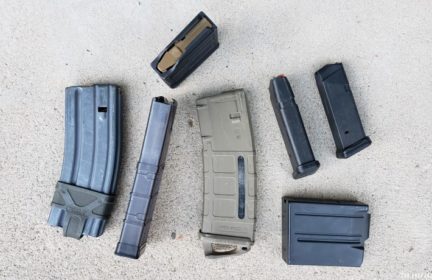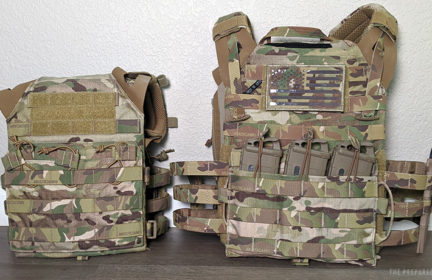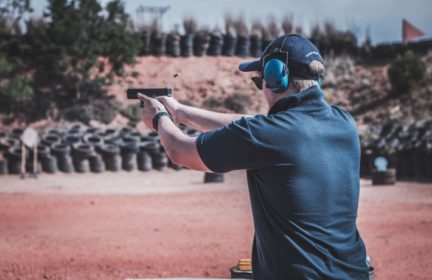AR-15 Maintenance Schedules and Guidelines
An AR-15 rifle purchased from a reputable manufacturer is extremely reliable, though it does need periodic maintenance to function correctly. Basic maintenance schedules discussed below.
Some key points about the AR-15 rifle.
- The AR-15 firearm was designed to shoot 1 round every 2 seconds (Sustained rate of fire). If you shoot faster than that, you will drastically heat the rifle, and reduce the barrel’s life.
- Consider the Ar-15 a mini precision rifle. Yes, it can shoot fast, but the weapon, with the right optics, is best used with deliberate, aimed fire.
- Magazines can be a source of malfunctions. If you have a bad magazine, throw it in the garbage or mark it for “training purposes only.”
- A 5.56/.223 mil-spec/military-grade rifle can run at least 15,000 rounds before the barrel needs to be replaced. Some higher-end barrels can go 20,000 rounds + before they need to be replaced. An indicator that the barrel is worn out is the rounds key-holeing (hitting the target sideways) or an extreme loss in accuracy at 100 yards.
- The bolt carrier group is one of the most critical components of the rifle. On a hobby rifle, shoot your gun until a lug cracks on the bolt, then replace the bolt. If your life depends on your rifle, replace the bolt carrier group every 10,000 rounds.
- If you can afford it, carry a spare bolt carrier group with you. If your rifle fails during training, there is a good chance it is a component in the bolt carrier group. Simply swapping the bolt carrier group can get you back in action.
- If you cannot afford a training rifle or another bolt carrier group, at a minimum, carry a spare bolt with you. Before you train, swap out your “SHTF” bolt with a training bolt.
- Every time you clean your bolt carrier group, check for cracks. Cracks form around the cam pin and the lugs on the bolt. If you are missing a lug on your bolt, it is time to replace the bolt.
- While checking the bolt carrier group, check your gas rings, extractor, and ejector. A great way to check gas rings is to extend the bolt, then stand the bolt carrier group upright with the weight balanced on the bolt. If the bolt carrier collapses on the bolt, replace the gas rings. This method only works on a “Mil-Spec” bolt carrier group. You can check your extractor by removing it from your bolt and looking at the lip that holds the bullet case. If there is still a lip and the metal is not worn down, it’s probably okay. Check the ejector by taking a shell casing, seat it in your bolt, and let it go. If the shell is flung 5 to 6 feet away, the ejector/ejector spring are probably okay.
- Firing pins last a long time, but it is not a bad idea to keep a spare.
- Modern, well maintained AR-15’s do not need as much cleaning as people think. Wiping down the bolt carrier group with a carbon remover like M Pro7 is more than adequate. You can also use a bore snake and clean the carbon out of your barrel.
- After you clean your chamber and bolt carrier group, make sure to lubricate your bolt carrier group.
- Don’t fret about copper in your barrel, only carbon. Carbon pits barrels.
- Once a year, or every 2,500 rounds, give your rifle a very detailed cleaning (carbon removal) and check all surfaces for cracks.
On a training or hobby gun, you can keep track of firing schedules and diligently replace parts, or shoot the rifle until it stops working and then start replacing parts. If you carry a gun for a living, take firing schedules and parts replacement seriously.
Basic Maintenance Schedule for a 5.56/.223 duty rifle with a 14.7 or 16 inch barrel/Carbine or Mid length gas system.
Please note, this is preventative maintenance. AR-15’s have been documented to run for 10,000 rounds + with no maintenance, save for lubrication. If you want to swap parts every 5,000 rounds, you will probably be okay.
- At 2,500 rounds, replace the extractor, extractor spring, and gas rings.
- At 5,000 rounds, replace the extractor, extractor spring, ejector, ejector spring, and gas rings. Check every surface for cracks, especially the bolt lugs and the cam pin area. You will need the bolt ejector tool, hammer, and punch to swap out the ejector and ejector spring.
- At 7,500 rounds, replace the extractor, extractor spring, and gas rings.
- At 10,000 rounds, replace the bolt carrier group, and buffer spring. Attach a precision rifle scope and shoot a few 3-round groups for accuracy.
- At 12,500 rounds, replace the extractor, extractor spring, and gas rings.
- At 15,000 rounds, replace the extractor, extractor spring, ejector, ejector spring, and gas rings and once again check accuracy. You will need the bolt ejector tool, hammer, and punch to swap out the ejector and ejector spring.
- At 17,500 rounds, replace the extractor, extractor spring, and gas rings.
- At 20,000 rounds, replace the bolt carrier group, buffer spring, and barrel. Have a certified armorer check out the system as a whole.
-
Comments (10)
-




